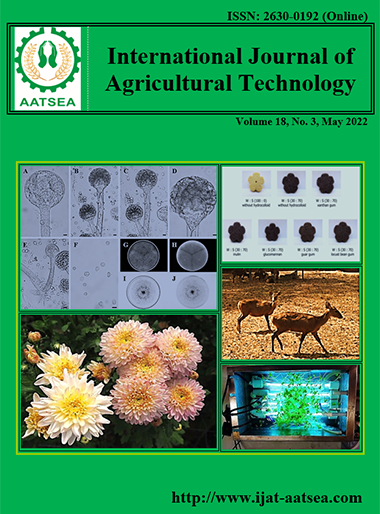Growth of diatom Amphora sp. cultured on agar plates by streak plate technique
Main Article Content
Abstract
Agar plate culturing is critical in a wide variety of scientific research, yet growing diatoms is challenging. The optimal agar concentration for Amphora sp. growth on f/2 medium and the duration of Amphora sp. survival on agar plates was identified. This study tested the simple approach for detecting cell colony growth on an agar plate by growing Amphora sp. in an F/2 medium with varying agar concentrations (0,4 percent, 0,6 percent, 0,7 percent). Following the discovery of the optimal agar concentration for Amphora sp. growth, the research continued with the regeneration of Amphora sp. from the old stock agar plate to the new plate of agar using the streak plate method. After Amphora sp. was cultured for four weeks, six weeks and eight weeks, regeneration was carried out on the new plates. Amphora sp. grew well on F/2 medium with a 0,4% agar concentration compared with other agar concentrations. The colony that appears became an indicator. Amphora sp. regeneration also showed that Amphora sp. was still growing well in new plates, all Amphora sp. from stock that was four weeks, six weeks, and eight weeks old, as indicated by the existence of multiple colonies and no contamination.
Article Details

This work is licensed under a Creative Commons Attribution-NonCommercial-NoDerivatives 4.0 International License.
References
Alam, M. A., Muhammad, G., Rehman, A., Russel, M., Shah, M. and Wang, Z. (2019). Standard techniques and methods for isolating, selecting and monitoring the growth of microalgal strain. In Microalgae Biotechnology for Development of Biofuel and Wastewater Treatment, Springer, pp.75-93.
Alam, M. A., Wang, Z. and Yuan, Z. (2017). Generation and harvesting of microalgae biomass for biofuel production. In Prospects and challenges in algal biotechnology, Springer, pp.89-111
Andersen, R. A. (2005). Algal culturing techniques, Elsevier.
Ariede, M. B., Candido, T. M., Jacome, A. L. M., Velasco, M. V. R., de Carvalho, J. C. M. and Baby, A. R. (2017). Cosmetic attributes of algae-A review. Algal Research, 25:483-487.
Avendaño-Herrera, R. E. and Riquelme, C. E. (2007). Production of a diatom-bacteria biofilm in a photobioreactor for aquaculture applications. Aquacultural Engineering, 36:97-104.
Aziz, N., Prasad, R., Ibrahim, A. I. and Ahmed, A. I. (2017). Promising applications for the production of biofuels through algae. In Microbial Biotechnology, Springer, pp.81-103
Brand, J. J., Andersen, R. A. and Nobles Jr, D. R. (2013). Maintenance of microalgae in culture collections. Handbook of microalgal culture: applied phycology and biotechnology, 80-89.
Capinpin Jr, E. C. (2007). Feeding, growth, and survival of post-larval abalone Haliotis asinina on different benthic diatoms. Science Diliman, 19.
Chtourou, H., Dahmen, I., Jebali, A., Karray, F., Hassairi, I., Abdelkafi, S. and Dhouib, A. (2015). Characterization of Amphora sp., a newly isolated diatom wild strain, potentially usable for biodiesel production. Bioprocess and biosystems engineering, 38:1381-1392.
De la Peña, M. (2007). Cell growth and nutritive value of the tropical benthic diatom, Amphora sp., at varying levels of nutrients and light intensity, and different culture locations. Journal of Applied Phycology, 19:647-655.
de Oliveira Lourenço, S. (2020). Microalgae culture collections, strain maintenance, and propagation. In Handbook of Microalgae-Based Processes and Products, Elsevier, pp.49-84.
de Viçose, G. C., Porta, A., Viera, M., Fernández-Palacios, H. and Izquierdo, M. (2012). Effects of density on growth rates of four benthic diatoms and variations in biochemical composition associated with growth phase. Journal of Applied Phycology, 24:1427-1437.
El Gamal, A. A. (2010). Biological importance of marine algae. Saudi pharmaceutical journal, 18:1-25.
Kimura, K. and Tomaru, Y. (2013). A unique method for culturing diatoms on agar plates. Plankton and Benthos Research, 8:46-48.
Kourtchenko, O., Rajala, T. and Godhe, A. (2018). Growth of a common planktonic diatom quantified using solid medium culturing. Scientific reports, 8:1-10.
Lakeman, M. B., Cattolico and Ann, R. (2007). Cryptic diversity in phytoplankton cultures is revealed using a simple plating technique 1. Journal of Phycology, 43:662-674.
Nagasaki, K. and Imai, I. (1994). Solid-phase culture of marine phytoflagellates. Bulletin of Japanese Society of Microbial Ecology, 9:37-43.
Parvin, M., Zannat, M. and Habib, M. (2007). Two important techniques for isolation of microalgae. Asian Fisheries Science, 20:117.
Scala, S. and Bowler, C. (2001). Molecular insights into the novel aspects of diatom biology. Cellular and Molecular Life Sciences CMLS, 58:1666-1673.
Shang, C., Wang, W., Zhu, S., Wang, Z., Qin, L., Alam, M. A. and Yuan, Z. (2018). The responses of two genes encoding phytoene synthase (Psy) and phytoene desaturase (Pds) to nitrogen limitation and salinity up-shock with special emphasis on carotenogenesis in Dunaliella parva. Algal Research, 32:1-10.
Sirakov, I., Velichkova, K., Stoyanova, S. and Staykov, Y. (2015). The importance of microalgae for aquaculture industry. Review. International Journal of Fisheries and Aquatic Studies, 2:81-84.
Suleria, H. A. R., Osborne, S., Masci, P. and Gobe, G. (2015). Marine-based nutraceuticals: An innovative trend in the food and supplement industries. Marine drugs, 13:6336-6351.
Van Colen, C., Lenoir, J., De Backer, A., Vanelslander, B., Vincx, M., Degraer, S. and Ysebaert, T. (2009). Settlement of Macoma balthica larvae in response to benthic diatom films. Marine Biology, 156:2161-2171.


